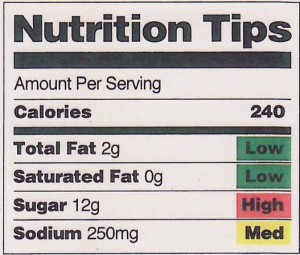Food agencies at work (or not): FDA
Front-of-Package Labels: The FDA is hard at work trying to do something about public understanding of food labels. What with the fuss about the Smart Choices program (now withdrawn), FDA wants to get the front-of-package labeling under control. It is considering various formats for giving a quick overview of the nutritional quality of food products. FDA is asking for public comment on the various formats (see Federal Register notice).
The FDA chose five versions (plus variations) for comment:
- A mini Nutrition Facts version called Nutrition Tips
- A UK traffic lights version
- A version like Hannaford’s Guiding Stars
- A version like the discontinued Smart Choices
- One that just highlights calories/servings
I rather like this one, a variation of #1 (colorful, easy to understand, not too cluttered, and makes calories clear).
The Nutrition Facts Panel: The FDA also is taking another look at the Nutrition Facts panel on the back of food packages. It is seeking public comment on a plan for consumer research to test understanding of elements on the Nutrition Facts panel. Here’s the Federal Register notice with all the information about what’s going on and where to file comments.
What’s interesting about this is that the FDA has great social science researchers on staff. They’ve been kept under wraps the last eight years and apparently are being let loose again. Even so, they don’t get to just go out and do studies like we academics do (with human subjects approval, of course). Oh no. First, they have to announce that they plan to do the studies (which they did some time ago) and get comments on the idea. Then they do the research plan and have to ask for further comments on the research design. That’s what this notice is about. Once they deal with these comments, they can finally get to work. It’s a miracle if they do anything at all. Keep them busy: send comments!
Agency Transparency: The Association of Health Care Journalists (ACHJ) and ten other journalism organizations have filed a complaint. The FDA, they say, is still requiring journalists to obtain permission from an agency official in order to conduct interviews with staff members. This is a leftover from the Bush administration. Time to get rid of it.
Blogging: It is especially time to open up to reporters because Michael Taylor, who is now senior advisor to the FDA commissioner, is now blogging on the Atlantic Food Channel (which also reprints my posts). If he can blog, FDA staff can talk to reporters.
Addendum: Beverages pretending to be dietary supplements: The FDA has just issued guidance to the beverage industry to stop putting herbal supplements into beverages and calling them dietary supplements so they can get around food rules on health claims. If a beverage is consumed as a food, it should be labeled as a food. Guidance, of course, is non-binding but I see this as a warning that the FDA is going to be enforcing its own rules. Good show!



